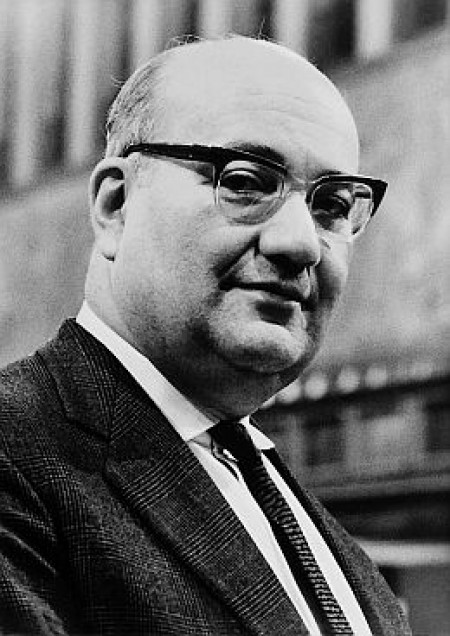
21 December 1913, Budapest – 9 February 1992, Zürich
The personality and art of Andor Földes evoked the atmosphere of a golden age for his immediate and extended environment. The inherited passion for music is linked to the personality of his maternal grandmother by the family chronicle. It is a fact that an early manifested talent did not count as a unique case in the family. The child prodigy, being an only child, was a private student until the end of his high school studies. Amongst such protected circumstances nature meant – understandably - a decisive experience besides music for him. He had time for contemplation and possibility for the development of his intellect, trained by practicing and lectures. Andor Földes estimated highly the human relationships, and intentionally sought to get acquainted with his greatest contemporaries in order to formulate a more concentrated, nicer-truer worldview. He had opportunity for encounters of this kind frequently; he could be delighted with life and find the intellectual environment suitable for him everywhere, and could not complain about the lack of interest regarding his art.
At the age of eight he played Mozart's Piano Concerto in B-flat major (K.450) under the baton of István Kerner, he was nine when playing Beethoven's Concerto No.1, and eleven years old when performing his Piano Concerto No.4 (the latter with his own cadenza). He did not become overconfident as a result of the comet-like beginning of his career. ‘Precocity that is not at all harmless is inherent in great art.' – as he wrote later in his reminiscences. At the age of fifteen he was the soloist of Liszt's Piano Concerto in E-flat major at a concert held for the twenty-fifth anniversary of the founding of the Fodor School of Music, with the accompaniment of the Budapest Philharmonic Society Orchestra under the baton of Ernő Dohnányi, later his professor at the Academy of Music. It was a game of circumstances that he entered the world of legends: as Beethoven kissed Liszt on the forehead in 1822, so accepted Liszt as an artist the sixteen year-old Emil Sauer from whom Andor Földes ‘inherited' in turn the muse's kiss.
He attended the Academy of Music between 1929 and 1932; but he gave recitals Europe-wide parallel with his studies. Soon he learned that the life of a touring artist is lasting from the hotel to the concert hall and back to the hotel. He lived his life according to that he cited frequently in Kodály's words: there is no significance of that a musician reaches until his age of eighteen; the only that matters is that he reached between the ages eighteen and seventy-five. Besides his professor, Ernő Dohnányi, Bartók had a great impact on him whom he met personally in 1929, and Wilhelm Backhaus meant a lifelong experience for him, with whom he could hear the 32 Piano Sonatas of Beethoven in the season of 1938/1939. Listening to music was a part of professional work for him from the beginning; he found it indispensable for a pianist to be able to become a musician. At the same time he was careful about not listening to master pieces too frequently, in order to avoid his ear would ‘get used to them.'
He left Hungary in 1939, and arrived to America after concerts in Europe. Following a decade of being a touring artist in Europe, he performed under a pseudonym as Andor Farkas, the accompanist of József Szigeti. From the age of thirty he practiced in memory and perhaps because of that, sitting at a piano was a renewable source of joy for him. The New York premiere of Bartók's Second Piano Concerto in 1947 is linked to his name, and we can keep him worthily a promoter of the Sonata. He was the first to play all three concertos of Bartók in one recital in 1955.
When he returned to Europe at the end of World War II, his first journey was to visit Beethoven's birthplace in Bonn. He followed the footsteps of Liszt when he gave charity recitals on five continents for the renovation of the Beethovenhalle. As he emphasized at the opening ceremony in 1959: each interpretation is a living being. It is born; it develops, unfolds, ages and finally dies. According to it, he kept a work on his repertoire until he struggled with that. When he felt that he solved all its secrets he included that no more in his programs.
He was not satisfied only with playing the piano: he conducted more than thirty orchestras world-wide. He considered re-contracting as the touchstone of success. He was proud of his achievements he did in ‘other fields than his own': his book that was first published in New York in 1948; titled Keys to the Keyboard: a Book for Pianists can be read in Hungarian since 1967, as well.
He taught at the College of Music in Saarbrücken from 1958 to the beginning of 1965 as the successor of Walter Gieseking, during which he continued his career as a touring artist. In his work as a pedagogue he considered musical self-criticism important, so that the students should hear what they really play. He expected intellectual freshness from the criticism.
He gave two recitals in Budapest in 1968 – his playing reaches music-lovers by archive recordings that are favorably increasing in number in the past couple of years. The world of the musician living in Switzerland from 1961 until his death has broadened gradually: as a child he considered himself as someone from Óbuda, around the age of eighteen he realizes that he is Hungarian, when he arrives to America then his consciousness of being European comes to the fore. When he obtained the American citizenship in 1948, he wanted to become from a white person – to a human being.
F. K.


